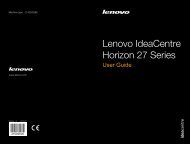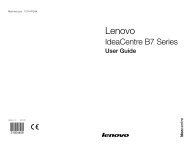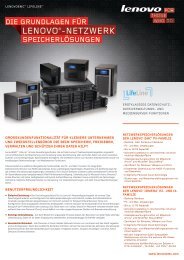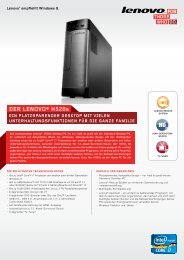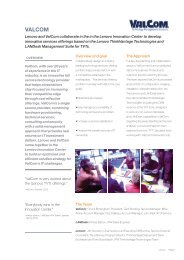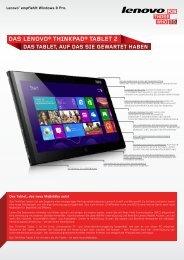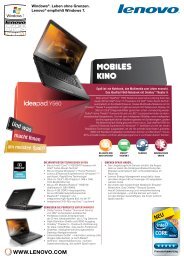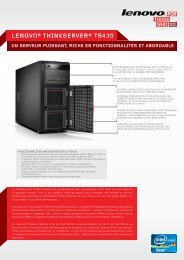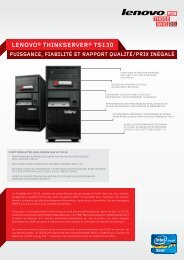UEFI on ThinkServer TS140 and TS440 - Lenovo
UEFI on ThinkServer TS140 and TS440 - Lenovo
UEFI on ThinkServer TS140 and TS440 - Lenovo
You also want an ePaper? Increase the reach of your titles
YUMPU automatically turns print PDFs into web optimized ePapers that Google loves.
<str<strong>on</strong>g>UEFI</str<strong>on</strong>g> <strong>on</strong> <strong>ThinkServer</strong> <strong>TS140</strong> <strong>and</strong> <strong>TS440</strong><br />
<strong>Lenovo</strong> <strong>ThinkServer</strong> TS Series Servers<br />
<strong>Lenovo</strong> Enterprise Product Group<br />
Versi<strong>on</strong> 1.0<br />
September 17, 2013<br />
©2013 <strong>Lenovo</strong>. All rights reserved.
<str<strong>on</strong>g>UEFI</str<strong>on</strong>g> <strong>on</strong> <strong>ThinkServer</strong> <strong>TS140</strong> <strong>and</strong> <strong>TS440</strong><br />
LENOVO PROVIDES THIS PUBLICATION “AS IS” WITHOUT WARRANTY OF ANY KIND, EITHER<br />
EXPRESS OR IMPLIED, INCLUDING, BUT NOT LIMITED TO, THE IMPLIED WARRANTIES OF NON-<br />
INFRINGEMENT, MERCHANTABILITY OR FITNESS FOR A PARTICULAR PURPOSE. This informati<strong>on</strong><br />
could include technical inaccuracies or typographical errors. Changes may be made to the<br />
informati<strong>on</strong> herein; these changes will be incorporated in new editi<strong>on</strong>s of the publicati<strong>on</strong>.<br />
<strong>Lenovo</strong> may make improvements <strong>and</strong>/or changes in the product(s) <strong>and</strong>/or the program(s)<br />
described in this publicati<strong>on</strong> at any time without notice.<br />
The following terms are trademarks of <strong>Lenovo</strong> in the United States, other countries, or both:<br />
<strong>Lenovo</strong>, <strong>and</strong> <strong>ThinkServer</strong>.<br />
Intel is a trademark of Intel Corporati<strong>on</strong> in the U.S. <strong>and</strong>/or other countries.<br />
Microsoft, Windows Storage Server 2012, Windows Server 2012, <strong>and</strong> the Windows Logo are<br />
trademarks of Microsoft Corporati<strong>on</strong> in the United States <strong>and</strong>/or other countries.<br />
2
<str<strong>on</strong>g>UEFI</str<strong>on</strong>g> <strong>on</strong> <strong>ThinkServer</strong> <strong>TS140</strong> <strong>and</strong> <strong>TS440</strong><br />
C<strong>on</strong>tents<br />
1.0 Overview ........................................................................................................................ 4<br />
2.0 What is <str<strong>on</strong>g>UEFI</str<strong>on</strong>g> .................................................................................................................. 4<br />
3.0 The Benefits of <str<strong>on</strong>g>UEFI</str<strong>on</strong>g> ...................................................................................................... 4<br />
4.0 <str<strong>on</strong>g>UEFI</str<strong>on</strong>g> Implementati<strong>on</strong> <strong>on</strong> <strong>ThinkServer</strong> ........................................................................... 5<br />
4.1 Boot Process .............................................................................................................. 5<br />
4.2 C<strong>on</strong>figuring Boot Opti<strong>on</strong>s .......................................................................................... 6<br />
4.3 Secure Boot Opti<strong>on</strong>s .................................................................................................. 8<br />
5.0 Installing a <str<strong>on</strong>g>UEFI</str<strong>on</strong>g> Aware Operating System .................................................................... 9<br />
5.1 C<strong>on</strong>figuring the RAID Subsystem ............................................................................... 9<br />
5.2 Booting an EFI Installati<strong>on</strong> Media <strong>and</strong> Installing the OS ......................................... 10<br />
3
<str<strong>on</strong>g>UEFI</str<strong>on</strong>g> <strong>on</strong> <strong>ThinkServer</strong> <strong>TS140</strong> <strong>and</strong> <strong>TS440</strong><br />
1.0 Overview<br />
This paper Introduces <strong>and</strong> describes key features of the <str<strong>on</strong>g>UEFI</str<strong>on</strong>g> firmware implementati<strong>on</strong> found <strong>on</strong><br />
the <strong>ThinkServer</strong> <strong>TS140</strong> <strong>and</strong> <strong>TS440</strong>. It also describes the procedures for c<strong>on</strong>figuring the system to<br />
install <str<strong>on</strong>g>UEFI</str<strong>on</strong>g> aware Operating Systems that take advantage of the new features available in the<br />
<str<strong>on</strong>g>UEFI</str<strong>on</strong>g> st<strong>and</strong>ard.<br />
2.0 What is <str<strong>on</strong>g>UEFI</str<strong>on</strong>g><br />
The Unified Extensible Firmware Interface (<str<strong>on</strong>g>UEFI</str<strong>on</strong>g>) specificati<strong>on</strong> describes an interface between<br />
an Operating System <strong>and</strong> the system firmware. <str<strong>on</strong>g>UEFI</str<strong>on</strong>g> firmware replaces the basic input/output<br />
system (BIOS), which has been in place for x86 pers<strong>on</strong>al computers <strong>and</strong> servers for decades, <strong>and</strong><br />
provides advantages not possible with the older technology.<br />
At system power-<strong>on</strong>, BIOS identifies <strong>and</strong> initializes the system’s hardware devices (such as the<br />
hard disk, video adapter, keyboard, <strong>and</strong> mouse). BIOS then loads the operating system from<br />
local storage (floppy, hard disk, CD-ROM, USB) or network, <strong>and</strong> passes c<strong>on</strong>trol to it. BIOS is<br />
specific to the Intel x86 processor architecture, <strong>and</strong> it relies <strong>on</strong> the 16-bit "real mode" interface<br />
supported by x86 processors.<br />
<str<strong>on</strong>g>UEFI</str<strong>on</strong>g> defines a similar interface that operates between the operating system <strong>and</strong> the platform<br />
firmware, but is st<strong>and</strong>ards based, <strong>and</strong> not specific to any processor architecture. <str<strong>on</strong>g>UEFI</str<strong>on</strong>g> provides<br />
data tables that c<strong>on</strong>tain system informati<strong>on</strong>, plus boot <strong>and</strong> runtime services that are available to<br />
the operating system <strong>and</strong> its loader.<br />
The <str<strong>on</strong>g>UEFI</str<strong>on</strong>g> st<strong>and</strong>ard was preceded by Extensible Firmware Interface Specificati<strong>on</strong> (EFI), developed<br />
by Intel in the mid-1990s to support the Itanium® class of processors. In 2005, the EFI st<strong>and</strong>ard<br />
was c<strong>on</strong>tributed to the <str<strong>on</strong>g>UEFI</str<strong>on</strong>g> Forum Inc., which now manages <strong>and</strong> evolves the <str<strong>on</strong>g>UEFI</str<strong>on</strong>g> specificati<strong>on</strong>.<br />
The <str<strong>on</strong>g>UEFI</str<strong>on</strong>g> Forum is an active st<strong>and</strong>ards body with many industry participants of which <strong>Lenovo</strong> is a<br />
c<strong>on</strong>tributing member, <strong>and</strong> a member of the Board of Directors.<br />
3.0 The Benefits of <str<strong>on</strong>g>UEFI</str<strong>on</strong>g><br />
A significant benefit of <str<strong>on</strong>g>UEFI</str<strong>on</strong>g> is that it is designed to overcome limitati<strong>on</strong>s imposed by the older<br />
BIOS architecture. Because BIOS is limited to a 16-bit processor mode <strong>and</strong> 1 MB of addressable<br />
space, space for advanced BIOS functi<strong>on</strong>ality is limited. Space for PCI opti<strong>on</strong> ROMs is also<br />
limited, restricting the number of adapters that can be installed, <strong>and</strong> how much functi<strong>on</strong>ality<br />
each Opti<strong>on</strong> ROM can c<strong>on</strong>tain. <str<strong>on</strong>g>UEFI</str<strong>on</strong>g> in comparis<strong>on</strong> supports either 32-bit or 64-bit processor<br />
modes. In 64-bit mode, <str<strong>on</strong>g>UEFI</str<strong>on</strong>g> applicati<strong>on</strong>s in the pre-boot executi<strong>on</strong> envir<strong>on</strong>ment have direct<br />
access to all of the memory in the system using 64-bit addressing.<br />
BIOS systems also support <strong>on</strong>ly disks that use the master boot record (MBR) partiti<strong>on</strong>ing<br />
scheme, which limits the maximum size of a disk to approximately 2.2 terabytes (TB), <strong>and</strong> a<br />
4
<str<strong>on</strong>g>UEFI</str<strong>on</strong>g> <strong>on</strong> <strong>ThinkServer</strong> <strong>TS140</strong> <strong>and</strong> <strong>TS440</strong><br />
maximum of 4 primary partiti<strong>on</strong>s. <str<strong>on</strong>g>UEFI</str<strong>on</strong>g> supports a more flexible partiti<strong>on</strong>ing scheme that uses a<br />
GUID Partiti<strong>on</strong> Table (GPT), which uses 64-bit values to describe partiti<strong>on</strong>s, allowing a maximum<br />
disk size of approximately 9.4 ZB, <strong>and</strong> 128 primary hard disk partiti<strong>on</strong>s. <str<strong>on</strong>g>UEFI</str<strong>on</strong>g> GPT support is<br />
therefore required to use boot disks greater than 2.2 TB in size.<br />
In additi<strong>on</strong> to providing st<strong>and</strong>ard boot services <strong>and</strong> support, <str<strong>on</strong>g>UEFI</str<strong>on</strong>g> provides a rich pre-boot<br />
envir<strong>on</strong>ment that is independent of the operating system. With support for networking, USB,<br />
high-resoluti<strong>on</strong> graphics, file system capabilities, <strong>and</strong> access to all devices, <str<strong>on</strong>g>UEFI</str<strong>on</strong>g> is capable<br />
enough to be called “OS like.” This envir<strong>on</strong>ment enables <str<strong>on</strong>g>UEFI</str<strong>on</strong>g> applicati<strong>on</strong>s to be executed,<br />
including the <str<strong>on</strong>g>UEFI</str<strong>on</strong>g> shell (a comm<strong>and</strong>-line envir<strong>on</strong>ment) that supports both human interacti<strong>on</strong><br />
<strong>and</strong> scripting.<br />
4.0 <str<strong>on</strong>g>UEFI</str<strong>on</strong>g> Implementati<strong>on</strong> <strong>on</strong> <strong>ThinkServer</strong><br />
<str<strong>on</strong>g>UEFI</str<strong>on</strong>g> firmware <strong>on</strong> the <strong>ThinkServer</strong> <strong>TS140</strong> <strong>and</strong> <strong>TS440</strong> c<strong>on</strong>forms to the <str<strong>on</strong>g>UEFI</str<strong>on</strong>g> st<strong>and</strong>ard versi<strong>on</strong> 2.3.<br />
It includes a Compatibility Support Module (CSM) that emulates “Legacy BIOS.” This allows the<br />
server to boot operating systems that are <str<strong>on</strong>g>UEFI</str<strong>on</strong>g>-aware as well as older operating systems that<br />
support <strong>on</strong>ly 16-bit BIOS.<br />
4.1 Boot Process<br />
The Legacy BIOS boot process boots selected devices (e.g. a DVD drive or HDD). In c<strong>on</strong>trast,<br />
<str<strong>on</strong>g>UEFI</str<strong>on</strong>g> boots specific files (targets) from physical or logical device paths, so boot media can<br />
c<strong>on</strong>tain virtually unlimited boot targets (operating-system instances).<br />
In <str<strong>on</strong>g>UEFI</str<strong>on</strong>g> bootable media, a special partiti<strong>on</strong> exists that c<strong>on</strong>tains the main <str<strong>on</strong>g>UEFI</str<strong>on</strong>g> boot loader<br />
located in the path \efi\boot\bootx64.efi. If the boot loader there is valid, the firmware will<br />
boot it automatically.<br />
For example, if a CD or DVD c<strong>on</strong>tains a <str<strong>on</strong>g>UEFI</str<strong>on</strong>g> boot record, the CD/DVD boots using <str<strong>on</strong>g>UEFI</str<strong>on</strong>g>. If the<br />
CD or DVD does not c<strong>on</strong>tain a <str<strong>on</strong>g>UEFI</str<strong>on</strong>g> boot record but instead c<strong>on</strong>tains an x86 boot record, the<br />
CD/DVD uses BIOS to boot (via the CSM). If both <str<strong>on</strong>g>UEFI</str<strong>on</strong>g> <strong>and</strong> x86 boot records are found <strong>on</strong> the<br />
device, the Boot Mode setting c<strong>on</strong>figured in BIOS setup will determine which method is tried<br />
first by default.<br />
Devices that can c<strong>on</strong>tain two bootable partiti<strong>on</strong>s (MBR <strong>and</strong> GPT for Legacy <strong>and</strong> <str<strong>on</strong>g>UEFI</str<strong>on</strong>g>) include<br />
CD’s, DVD’s, diskette drives, <strong>and</strong> removable USB drives.<br />
Hard disk drives can c<strong>on</strong>tain either a MBR or GPT partiti<strong>on</strong> table; MBR partiti<strong>on</strong>s <strong>and</strong> GPT<br />
partiti<strong>on</strong>s cannot coexist <strong>on</strong> the same volume, so hard disk drives cannot be dual booted (legacy<br />
<strong>and</strong> <str<strong>on</strong>g>UEFI</str<strong>on</strong>g>). However, multiple bootable <str<strong>on</strong>g>UEFI</str<strong>on</strong>g> partiti<strong>on</strong>s can be created <strong>on</strong> the same hard drive,<br />
<strong>and</strong> the boot manager will list each GPT partiti<strong>on</strong> <strong>on</strong> the hard disk drive that also includes a <str<strong>on</strong>g>UEFI</str<strong>on</strong>g><br />
boot record.<br />
5
<str<strong>on</strong>g>UEFI</str<strong>on</strong>g> <strong>on</strong> <strong>ThinkServer</strong> <strong>TS140</strong> <strong>and</strong> <strong>TS440</strong><br />
4.2 C<strong>on</strong>figuring Boot Opti<strong>on</strong>s<br />
During POST, the “Startup Manager” (the boot manager) will identify <strong>and</strong> enumerate any<br />
bootable device, or <str<strong>on</strong>g>UEFI</str<strong>on</strong>g> boot target found <strong>on</strong> any device. Boot opti<strong>on</strong>s are created for these<br />
devices <strong>and</strong> <str<strong>on</strong>g>UEFI</str<strong>on</strong>g> boot targets, <strong>and</strong> entries are made in the Boot Sequence menu. The boot<br />
opti<strong>on</strong>s listed, however, are dependent <strong>on</strong> the CSM <strong>and</strong> Boot Mode opti<strong>on</strong>s c<strong>on</strong>figured in BIOS<br />
Startup. Table 1 describes how the Boot Mode opti<strong>on</strong>s affect the boot targets that are available<br />
in the list.<br />
Table 1 – Boot Mode Opti<strong>on</strong>s<br />
CSM Mode Boot Mode Boot Priority Result<br />
Disabled <str<strong>on</strong>g>UEFI</str<strong>on</strong>g> Only Not available<br />
Enabled Auto <str<strong>on</strong>g>UEFI</str<strong>on</strong>g> First<br />
Enabled Auto Legacy First<br />
Enabled <str<strong>on</strong>g>UEFI</str<strong>on</strong>g> Only Not available <str<strong>on</strong>g>UEFI</str<strong>on</strong>g> Boot <strong>on</strong>ly.<br />
Enabled Legacy Only Not available<br />
<str<strong>on</strong>g>UEFI</str<strong>on</strong>g> Boot <strong>on</strong>ly. This mode is required to<br />
enable Secure Boot mode in supported<br />
operating systems. Only <str<strong>on</strong>g>UEFI</str<strong>on</strong>g> targets will be<br />
listed in the Boot Sequence opti<strong>on</strong>s.<br />
Will try <str<strong>on</strong>g>UEFI</str<strong>on</strong>g> boot first, then Legacy. Both<br />
modes will be listed in the Boot Sequence<br />
opti<strong>on</strong>s.<br />
Will try Legacy first, then <str<strong>on</strong>g>UEFI</str<strong>on</strong>g>. Both modes<br />
will be listed in the Boot Sequence opti<strong>on</strong>s.<br />
Legacy Boot <strong>on</strong>ly. Only Legacy boot devices<br />
will be listed in the Boot Sequence opti<strong>on</strong>s.<br />
The CSM <strong>and</strong> Boot Mode settings are c<strong>on</strong>figured in the BIOS Startup screen (see Figure 1).<br />
Figure 1 – Startup Opti<strong>on</strong>s<br />
6
<str<strong>on</strong>g>UEFI</str<strong>on</strong>g> <strong>on</strong> <strong>ThinkServer</strong> <strong>TS140</strong> <strong>and</strong> <strong>TS440</strong><br />
The Boot Sequence (see Figure 2) screen provides a single list of all boot opti<strong>on</strong>s available. From<br />
this list, the order of precedence can be c<strong>on</strong>figured.<br />
Figure 2 – Primary Boot Sequence Priority<br />
The “Primary Boot Sequence” is used when the <strong>ThinkServer</strong> is powered <strong>on</strong> or rebooted. The<br />
“Automatic Boot Sequence” is used when a communicati<strong>on</strong>s device wakes up the system (for<br />
example, Wake <strong>on</strong> LAN), <strong>and</strong> the “Error Boot Sequence” is used when a boot error has occurred.<br />
This automatic selecti<strong>on</strong> behavior can be c<strong>on</strong>figured permanently in the Startup screen, or<br />
overridden in the “Startup Device Menu” (see Figure 4) where a <strong>on</strong>e-time boot selecti<strong>on</strong> can be<br />
made. The “Startup Device Menu” is accessible by pressing “F12” at system startup.<br />
Although <strong>ThinkServer</strong> <str<strong>on</strong>g>UEFI</str<strong>on</strong>g> firmware supports both <str<strong>on</strong>g>UEFI</str<strong>on</strong>g> <strong>and</strong> BIOS boot processes through the<br />
Boot Manager, <strong>on</strong>ce a BIOS device is booted <strong>and</strong> the <str<strong>on</strong>g>UEFI</str<strong>on</strong>g> CSM is invoked for the boot, the<br />
system cannot return to the <str<strong>on</strong>g>UEFI</str<strong>on</strong>g> boot manager.<br />
7
<str<strong>on</strong>g>UEFI</str<strong>on</strong>g> <strong>on</strong> <strong>ThinkServer</strong> <strong>TS140</strong> <strong>and</strong> <strong>TS440</strong><br />
Figure 3 – Startup Device Menu for Boot Order Override<br />
4.3 Secure Boot Opti<strong>on</strong>s<br />
Secure Boot is used to prevent unauthorized operating systems from running <strong>on</strong> the system.<br />
This feature is supported with most current generati<strong>on</strong> Microsoft operating systems, but does<br />
not exclude other supported Secure Boot operating Systems. Secure Boot is enabled in the<br />
Security tab in BIOS Setup (see Figure 4). Secure Boot requires CSM mode to be disabled <strong>and</strong><br />
<str<strong>on</strong>g>UEFI</str<strong>on</strong>g> mode set to “<str<strong>on</strong>g>UEFI</str<strong>on</strong>g> Only.” Setting Secure Boot to “enabled” will force the Boot Mode<br />
opti<strong>on</strong>s to be c<strong>on</strong>figured.<br />
Figure 4 – Secure Boot Settings<br />
8
<str<strong>on</strong>g>UEFI</str<strong>on</strong>g> <strong>on</strong> <strong>ThinkServer</strong> <strong>TS140</strong> <strong>and</strong> <strong>TS440</strong><br />
5.0 Installing a <str<strong>on</strong>g>UEFI</str<strong>on</strong>g> Aware Operating System<br />
Only certain Operating Systems are <str<strong>on</strong>g>UEFI</str<strong>on</strong>g> aware <strong>and</strong> can take advantage of the benefits of <str<strong>on</strong>g>UEFI</str<strong>on</strong>g>,<br />
in particular GPT support for boot drives. All of the operating systems supported <strong>on</strong> the<br />
<strong>ThinkServer</strong> <strong>TS140</strong> <strong>and</strong> <strong>TS440</strong> are <str<strong>on</strong>g>UEFI</str<strong>on</strong>g> aware.<br />
The following example describes the steps for installing Windows Server 2012 into a GPT<br />
partiti<strong>on</strong> <strong>on</strong> <strong>ThinkServer</strong> <strong>TS140</strong> or <strong>TS440</strong>. These steps are similar for installing <str<strong>on</strong>g>UEFI</str<strong>on</strong>g> aware Linux<br />
distributi<strong>on</strong>s.<br />
5.1 C<strong>on</strong>figuring the RAID Subsystem<br />
<str<strong>on</strong>g>UEFI</str<strong>on</strong>g> mode is supported for all storage <strong>and</strong> RAID c<strong>on</strong>figurati<strong>on</strong>s supported by the <strong>ThinkServer</strong>s,<br />
however, the RAID subsystem c<strong>on</strong>figurati<strong>on</strong> must be performed in Legacy (BIOS) mode with<br />
CSM Mode enabled. After the RAID subsystem has been c<strong>on</strong>figured, the desired Boot Mode<br />
settings can be c<strong>on</strong>figured.<br />
The basic steps to c<strong>on</strong>figure the RAID subsystem include:<br />
1. C<strong>on</strong>figure CSM to Enabled<br />
2. C<strong>on</strong>figure the SATA C<strong>on</strong>troller mode if required in BIOS<br />
3. C<strong>on</strong>figure the RAID subsystem using the RAID pre-boot envir<strong>on</strong>ment<br />
4. Rec<strong>on</strong>figure Boot Mode to the desired state<br />
The following example describes these steps.<br />
1. Power <strong>on</strong> the server.<br />
2. Press the F1 key to enter the “BIOS<br />
Setup Utility.”<br />
9
<str<strong>on</strong>g>UEFI</str<strong>on</strong>g> <strong>on</strong> <strong>ThinkServer</strong> <strong>TS140</strong> <strong>and</strong> <strong>TS440</strong><br />
3. From the BIOS Setup Utility, select the<br />
“Startup” tab from the menu, <strong>and</strong> then<br />
select “CSM” <strong>and</strong> set it to “Enabled.”<br />
4. Press F10 to Save <strong>and</strong> Exit the BIOS setup screens <strong>and</strong> reboot the <strong>ThinkServer</strong>.<br />
5. At the prompt, type the hot-key sequence to enter the RAID preboot c<strong>on</strong>figurati<strong>on</strong> utility.<br />
Complete c<strong>on</strong>figurati<strong>on</strong> of the RAID array, <strong>and</strong> reboot the system.<br />
6. At this point, the BIOS Setup Utility can be entered to rec<strong>on</strong>figure the Boot Mode opti<strong>on</strong>s <strong>and</strong><br />
Boot Sequence settings if desired.<br />
5.2 Booting an EFI Installati<strong>on</strong> Media <strong>and</strong> Installing the OS<br />
This secti<strong>on</strong> describes booting the Installati<strong>on</strong> media <strong>and</strong> installing a <str<strong>on</strong>g>UEFI</str<strong>on</strong>g> aware OS into a GPT<br />
partiti<strong>on</strong>.<br />
A BIOS-bootable operating system can <strong>on</strong>ly be installed to a master boot record (MBR) partiti<strong>on</strong>.<br />
An EFI-bootable operating system can <strong>on</strong>ly be installed to a GPT partiti<strong>on</strong>. Therefore, if a<br />
selected partiti<strong>on</strong> is MBR, it is BIOS-booted; if it is GPT, it is EFI-booted. Before installing a <str<strong>on</strong>g>UEFI</str<strong>on</strong>g>aware<br />
operating system <strong>on</strong> a hard disk that is already formatted with an MBR, delete all<br />
partiti<strong>on</strong>s from the disk, or reformat the disk with GPT.<br />
If the Boot Mode is set to “Legacy Only,” the Boot Priority must be overridden in order to force<br />
the installati<strong>on</strong> to use the EFI boot target. In additi<strong>on</strong>, if The <strong>TS140</strong> or <strong>TS440</strong> is using RAID 100,<br />
<strong>and</strong> CSM is disabled, device drivers will need to be provided during installati<strong>on</strong>.<br />
10
<str<strong>on</strong>g>UEFI</str<strong>on</strong>g> <strong>on</strong> <strong>ThinkServer</strong> <strong>TS140</strong> <strong>and</strong> <strong>TS440</strong><br />
1. Enter the Boot Manager menu either<br />
by pressing Enter then select F12, or<br />
reboot the server <strong>and</strong> press F12.<br />
Select the <str<strong>on</strong>g>UEFI</str<strong>on</strong>g> tagged device where<br />
the install media is located, in this<br />
example <strong>on</strong>:<br />
<str<strong>on</strong>g>UEFI</str<strong>on</strong>g>: PLDS DVDROM DS8A9SH<br />
(NOTE: Legacy:PLDS DVDROM<br />
DS8A9SH represents the legacy mode<br />
x86 boot device).<br />
Press ENTER to begin the installati<strong>on</strong>.<br />
2. When the Upgrade / Install screen is<br />
presented, select “Custom” install.<br />
3. If the system is using RAID 100, <strong>and</strong><br />
CSM was disabled, Windows will not<br />
see a disk at this time. Device drivers<br />
will need to be provided in order to<br />
complete the installati<strong>on</strong>.<br />
All other c<strong>on</strong>figurati<strong>on</strong>s can skip to step<br />
6.<br />
11
<str<strong>on</strong>g>UEFI</str<strong>on</strong>g> <strong>on</strong> <strong>ThinkServer</strong> <strong>TS140</strong> <strong>and</strong> <strong>TS440</strong><br />
4. Click “Browse” to locate the device<br />
driver.<br />
5. Select the device driver for the RAID<br />
100 device, <strong>and</strong> click “Next.”<br />
6. “Disk 1 Unallocated Space” will now be<br />
visible, <strong>and</strong> can be selected as the<br />
target for the installati<strong>on</strong>.<br />
12
<str<strong>on</strong>g>UEFI</str<strong>on</strong>g> <strong>on</strong> <strong>ThinkServer</strong> <strong>TS140</strong> <strong>and</strong> <strong>TS440</strong><br />
7. At the completi<strong>on</strong> of the Operating<br />
System installati<strong>on</strong>, the <str<strong>on</strong>g>UEFI</str<strong>on</strong>g> firmware<br />
will insert a <str<strong>on</strong>g>UEFI</str<strong>on</strong>g> Boot entry into the<br />
Boot Sequence list as shown here.<br />
In this example, the RAID 100 volume is<br />
displayed as “Intel Volume0.” RAID<br />
500 <strong>and</strong> RAID 700 will display as “Other<br />
Device: (Bus Info) PCI RAID Adapter.”<br />
8. The partiti<strong>on</strong>s created during the<br />
installati<strong>on</strong> can be verified. For<br />
new installati<strong>on</strong>s, by default,<br />
Windows Setup creates a system<br />
partiti<strong>on</strong> (that is, an Extensible<br />
Firmware Interface System<br />
partiti<strong>on</strong>, also called EFI System Partiti<strong>on</strong>, or ESP), a Microsoft Reserved partiti<strong>on</strong> (MSR), <strong>and</strong> a<br />
Windows partiti<strong>on</strong>.<br />
Windows Setup creates a system partiti<strong>on</strong> when:<br />
i. There is no existing system partiti<strong>on</strong>.<br />
ii. There is enough disk space to create a 100 MB partiti<strong>on</strong>.<br />
Windows Setup creates the MSR when:<br />
iii. There is no existing MSR.<br />
iv. There is enough disk space to create a 128 MB partiti<strong>on</strong>.<br />
Creating the system partiti<strong>on</strong> takes priority over the MSR because the system partiti<strong>on</strong> is required<br />
to boot the computer.<br />
13



